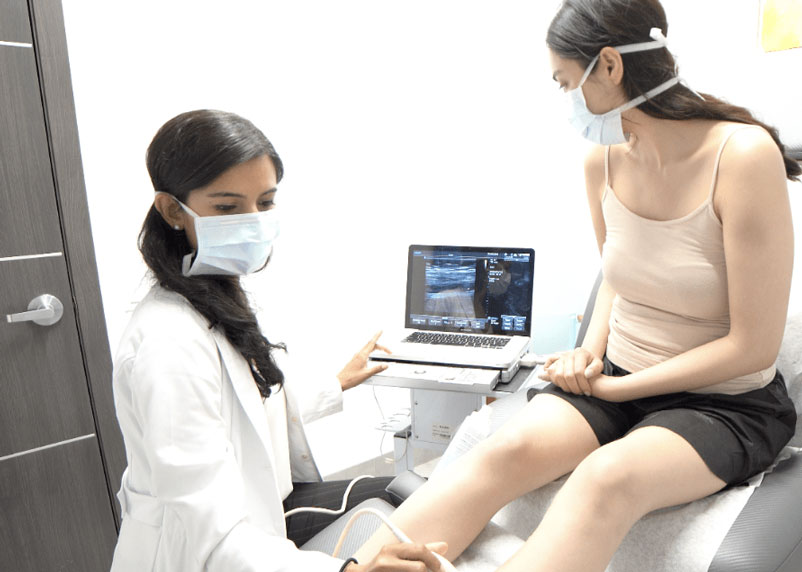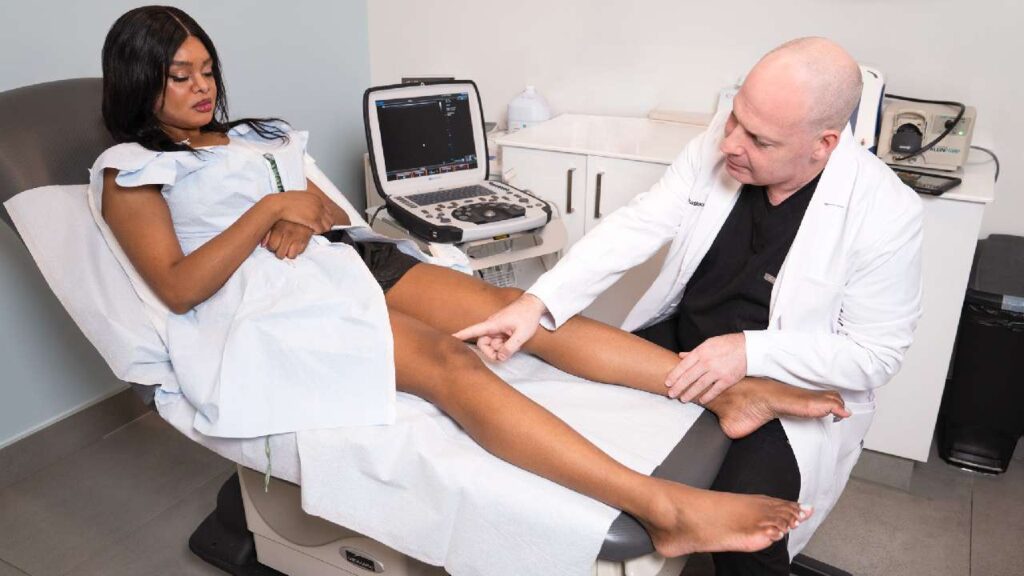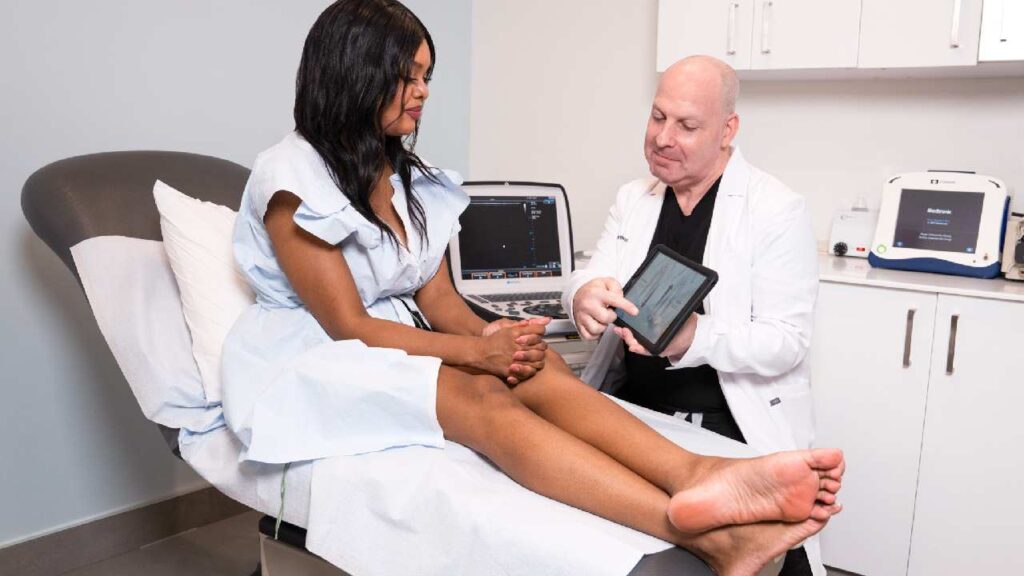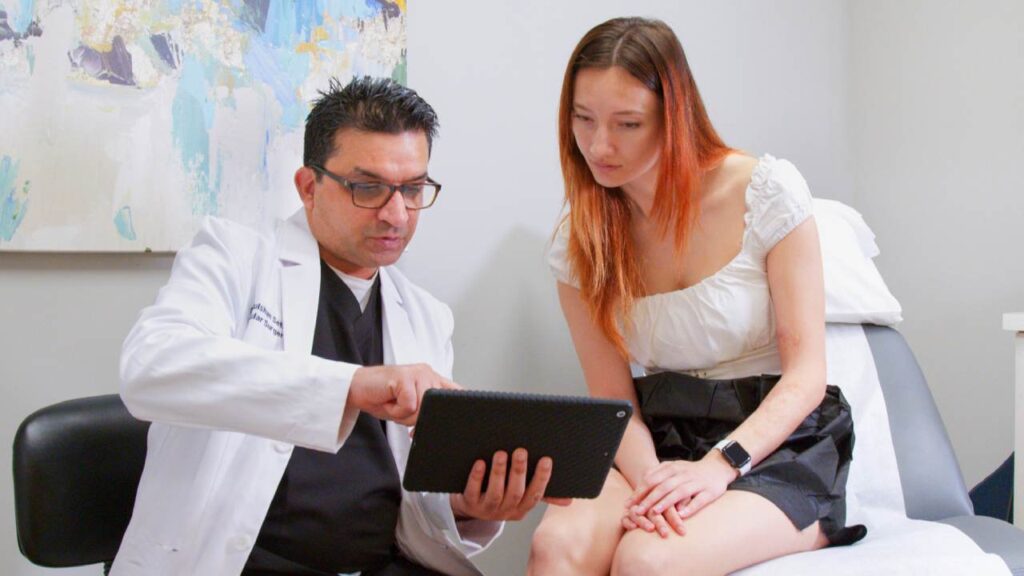What Are Varicose Veins?
Varicose veins are blood vessels that become swollen and twisted from elevated endovenous pressure. Various things raise pressure in a vein. A common one in Chronic Venous Insufficiency. With this condition, vein valves don’t close tightly after blood flows through. So, blood leaks backward and accumulates beneath the valve. This causes engorgement which creates tortuous, protuberant varicose veins beneath your skin. In most cases, varicose veins aren’t life-threatening. But they can indicate serious problems in deeper veins, including a deep vein thrombosis which can cause a pulmonary embolism. Book an appointment with our New York City vein specialists to prevent complications.
What Are the Symptoms of Varicose Veins?
Varicose veins can be asymptomatic, mildly or moderately symptomatic, or debilitating. The most common symptoms of varicose veins include heaviness, swelling, cramping, fatigue, itching, restlessness, and aching in the legs. Left untreated, some varicose veins cause slow-healing ulcers that can become infected, as well as venous stasis dermatitis. Some patients experience bleeding that’s hard to control if the varicose vein gets scraped. Hyperpigmentation and skin discoloration are also possible complications, along with blood clots. If you have varicose veins in your legs, and you notice that your legs feel heavy, tired, or crampy, especially at the end of the day, it’s likely that you have venous insufficiency. Visit a New York City vein doctor to prevent worsening symptoms.

What Are the Risk Factors for Varicose Veins?
As mentioned, elevated endovenous pressure is the main cause of varicose veins. Various things increase pressure in the veins. Female hormone fluctuations are a big risk factor, because these affect blood pressure as well as the vein walls themselves. If you’re inactive, blood can accumulate in your veins and stretch them, which makes it harder for vein valves to create a tight seal. Obesity puts extra pressure on your veins. Standing or sitting for long periods of time adds pressure and also limits the number of leg muscle contractions, which help the leg veins pump blood. Aging weakens vein walls and valves, making venous reflux more likely. The number one risk factor, however, is a family history of varicose veins. Here are the common causes.
- A family history of varicose veins
- Chronic Venous Insufficiency
- Pregnancy
- Obesity
- Female gender
- Hormone replacement therapy
- Menopause
- Birth control usage
- Sedentary lifestyle
- Jobs that require standing or sitting for long periods
- Aging
Do Enlarged Veins Indicate a Deep Vein Thrombosis?
A bulging varicose vein is not the same thing as a blood clot. A clot in a surface vein can cause a sudden, raised, red, warm spot. If you develop one of these, see a doctor promptly. Other times, clots aren’t visible through the skin. A deep vein thrombosis is a clot in a deeper vein, which means you can’t see it. If a clot in a deep vein breaks loose, it can move toward the lungs and block a vital pulmonary artery. This is called a pulmonary embolism, and it’s life-threatening. Symptoms include chest pain, trouble breathing, coughing, or fainting. Head to the emergency room if you have these symptoms.
Varicose veins don’t cause pulmonary embolisms directly since varicosities are in superficial veins. However, varicose veins often indicate that there is a problem in deeper veins. So, if you develop varicose veins, it’s wise to have a venous ultrasound or vein mapping test that identifies any malfunctions in deeper blood vessels.
What’s the Difference Between Spider and Varicose Veins?
Spider veins and varicose veins often share the same cause–Chronic Venous Insufficiency. But they also have different causes, and they don’t look the same. Varicose veins are swollen, bulging, twisted veins. They’re larger and more protuberant than other veins. Spider veins are tiny and non-protrusive. They often form in small clusters with a central point and several branches that resemble a spider’s legs or a spider web. Treatment for both is quick and gentle, but it’s important to find the cause, so you don’t develop more.
How Does a New York City Vein Doctor Treat Varicose Veins?
The best treatment for most people is a minimally invasive procedure. Surgery is no longer necessary for the majority of veins now that gentler technology has emerged. Here are some of the top spider and varicose vein treatment options in New York.
- Sclerotherapy Injections (Asclera, Varithena)
- Cyanoacrylate Glue Injections (VenaSeal)
- Mechanochemical Ablation (ClariVein)
- Radiofrequency Ablation (ClosureFast)
Do Compression Stockings Eliminate Varicose Veins?
Compression stockings don’t eliminate varicose veins or the underlying cause. They can reduce symptoms in certain patients, but they don’t work for everyone. In addition, compression stockings aren’t safe for everyone, and they require a doctor’s help to select. Excessive or insufficient compression can both be problematic. If you have high blood pressure, blood clots, heart disease, or other cardiovascular issues, compression therapy requires a doctor’s approval. Patients with venous ulcerations, infections, or venous stasis dermatitis might not be able to wear compression stockings because of skin irritation. Consult a vein specialist before trying any type of support hose.
Does NYC Vein Treatment Require General or Local Anesthesia?
Minimally invasive vein treatments do not require general or spinal anesthesia. This makes them safer, faster, and easier to recover from. Many of them do not necessitate local anesthesia either. Asclera, Varithena, VenaSeal, and ClariVein are performed without anesthesia. Thermal procedures like ClosureFast require an injection of tumescent anesthesia around the vein before heating the blood vessel with radiofrequency. This is just to protect the surrounding area from heat. You remain awake and mobile and can walk around immediately after the procedure.
How Do You Know Which Varicose Vein Treatment to Choose?
There’s no vein treatment that’s right for everyone since we all have different medical histories and venous pathways. Our New York vein specialists will conduct a thorough exam, order tests if needed, and discuss your treatment goals and preferences. Since we have a wide array of treatment options, most patients can choose from a few. We even combine modalities as needed for individualized vein care. The size, symptoms, and severity of your veins help us select the treatment plan. But we’ll also consider your insurance coverage and what sounds the most appealing to you. We love creating a flawless finish that restores our patients’ confidence and youthful skin. Visit our Midtown Manhattan vein clinic near Bryant Park, or visit our Financial District vein clinic near New York-Presbyterian Lower Manhattan Hospital to get started!





